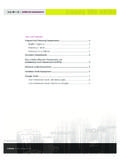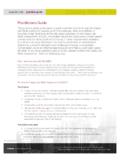Transcription of Ending Homelessness: The Philanthropic Role
1 EndingHomelessness:The Philanthropic RolePresented byThe National Foundation AdvisoryGroup for Ending Homelessness6718 Tcovers 9/22/03 4:26 PM Page 1 Butler family FundCharles and Helen Schwab Kellogg FoundationAnnie E. casey FoundationMorris and Esther Horowitz family FoundationThe Linden FoundationPeter BeardSenior Vice President of Knowledge Access and Technology StrategyFannie Mae Foundation Washington, DC Cassandra BenjaminProgram Officer on homelessness Charles and Helen Schwab FoundationSan Mateo, CA Carol BerdeExecutive Vice PresidentThe McKnight FoundationMinneapolis, MN Mark HorowitzTrusteeMorris and Esther Horowitz FamilyFoundationKansas City, MOMargen KelseyExecutive DirectorThe Linden FoundationBoston, MACarol LamontProgram OfficerNeighborhood & Community DevelopmentThe San Francisco FoundationSan Francisco, CA Terry Saunders LaneVice President for ProgramsThe Boston FoundationBoston.
2 MA Spence LimbockerExecutive Director Neighborhood Funders GroupWashington, DCMelinda Marble Executive Director/Grants AdministratorPaul and Phyllis Fireman Charitable Foundation Chestnut Hill, MA Michael MarcusSenior Program OfficerThe Chicago Community TrustChicago, ILMarvin McKinney, Kellogg FoundationBattle Creek, MI Jeff SchafferSenior Program OfficerConrad N. Hilton FoundationReno, NVMartha TollExecutive DirectorButler family FundWashington, DCSherece WestProgram AssociateAnnie E. casey Foundation Baltimore, MD Ronald Director of Philanthropic ServicesTides FoundationSan Francisco, CA Research, writing, and editorial support provided by the National Center on art and details: Rising Moon by HansHofmann, 1965.
3 2003 Estate of Hans Hofmann/Artists Rights Society (ARS), New YorkPROJECT FUNDERSTHE NATIONAL FOUNDATION ADVISORY GROUP FOR Ending HOMELESSNESSP hotos and images courtesy of: George Ceolla andthe National Center on family homelessness (pp. 4,22), the Chicago Continuum of Care (p. 13), TheMinneapolis Foundation (p. 10), The San FranciscoFoundation (p. 15), and Charles and Helen SchwabFoundation (pp. 3, 6, 8, 9, 14, 20, 25, 30).Design and Layout by Gayla Godby6718 Tcovers 9/22/03 4:26 PM Page 2 Ending homelessness :The Philanthropic RoleDear Colleague:Just over a year ago, a number of foundations concerned about the growing problem of homelessness in America began a collaboration to increase the role of philanthropy in addressing this national crisis.
4 This initiative is based on the beliefthat foundations large and small can play a significant role in helping to end guide is the third in a series of papers published by the Neighborhood Funders Group to help grantmakers betterunderstand affordable housing public policy issues and to encourage sustained, strategic public and private investmentsin housing and homelessness . It summarizes key recommendations from foundation staff and experts on what philanthropy can do to help end homelessness , and provides concrete examples of involvement by foundations of all sizes in this issue. It describes renewed energy and concrete plans that are fueling a growing consensus that home-lessness can be ended in the next foundations have launched important initiatives tailored to specific homeless populations and their urgent commend our Philanthropic colleagues who are engaged in this work and encourage others to consider homelessnessas a part of their grantmaking.
5 Local and national efforts to end homelessness offer opportunities for any foundationinvolved in human services to make a now know how to prevent and end homelessness and have an unprecedented opportunity for decisive action we hope you will join ,The National Foundation Advisory Group for Ending Homelessness6718 Tltr 9/16/03 7:49 AM Page 16718 Tltr 9/16/03 7:49 AM Page 2 Table of ContentsExecutive Summary .. 2 How this Guide was Developed .. 4 Overview: homelessness and Philanthropy .. 5 homelessness in the United StatesPhilanthropy s Role in Ending homelessness Strategies to Make a Difference.. 8 Building Political WillCommunity Planning to End HomelessnessPreventing HomelessnessExpanding Housing SupplyMaintaining Housing Through Supportive ServicesPutting It All Together.
6 22A Call to Action .. 25 Resources .. 26 Appendix .. 3016718T 9/23/03 10:40 AM Page 12 homelessness became a significant social problem in the1980s. The number of people experiencing homelessness hasrisen steadily to the present levels of three to four millionannually more than 1% of the population. Yet there is reason to hope that we can end homelessness within a decade. Much is known about the causes and effects of homeless-ness. Field-tested services and programs are available to provide safe, decent affordable housing. Stabilizing supportservices help people stay housed and provide needed assis-tance to particularly vulnerable populations. Detailed plans to eradicate homelessness have been developed at local andnational levels.
7 Community-based coalitions, governments,and foundations are poised for an historic collaboration, giving us good reason to believe we can end foundations do not include homelessness among theirfunding priorities. Historically, only about 1% of annual givinghas gone to homelessness . Most of these grants have gonetoward human service programs that only ameliorate the condition of homelessness instead of Ending it. Foundations that do give to homelessness represent alltypes large and small, corporate, community, and family . Executive SummaryThis guide outlines various strategic contributions that foundations can make to prevent and end homelessness : Advocacy and public education to increase the understanding of homelessness , build public will, and make change to local, state, and national policies.
8 Community planning to bring all stakeholders to the table with the explicit purpose of Ending homelessness . Prevention programs and systems change to intervene before people become homeless. Housing production, rehabilitation, and preservation to maintain and expand the supply of affordable housing. Integration of fragmented systems to provide coordinated and comprehensive services. Specialized supportive services to keep formerly homeless people , these exemplary programs will inspire more foundations to realize that Ending homelessness is an integralcomponent of their missions and prompt them to accelerate a historically minimal level of funding in this area. If all founda-tions engaged in human services join forces in local and nationalefforts, homelessness can be ended before it becomes a permanent feature of the national 9/23/03 10:40 AM Page 23 If foundations join forces in localand national efforts, homelessnesscan be ended before it becomes apermanent feature of the nationallandscape.
9 6718T 9/23/03 10:40 AM Page 3 HOW This Guide Was DevelopedA group of concerned foundations have joined forces to engagebroad Philanthropic support for Ending homelessness . This guideis a product of that collaboration. Its purpose is to: Understand philanthropy s historical commitment to homelessness . Highlight effective grantmaking strategies for preventing and Ending homelessness . Engage new levels of Philanthropic support and collaboration to end project analyzed homeless giving trends of the 1,000largest foundations between 1990 and 1999 from data provided bythe Foundation Center to understand philanthropy s historical conducted standardized telephone interviews with staff at 50foundations that currently or previously funded homelessness withthe goal of understanding how to gain, sustain, and increase foun-dation support.
10 We researched examples of innovative and effec-tive grantmaking in homelessness to highlight strategies that havemade a difference. We contacted more than 70 experts working directly on home-lessness to explore their views on what foundations could supportand how best to provide funding. This broad cross-section includ-ed providers, advocates, policymakers, researchers, and homelessand formerly homeless people. More information about the projectmethodology is in the 9/23/03 10:40 AM Page 45 homelessness in the United StatesA precise count of homeless people in the United States is elusive. The population is transient, turns over rapidly, and is difficult to locate. Reliable assessments converge on estimates ofthree to four million people experiencing homelessness annually(Urban Institute, 2000).





